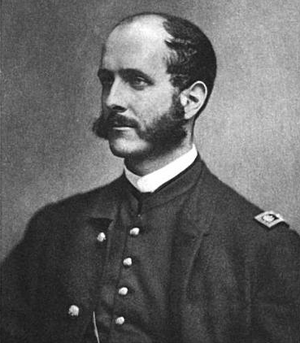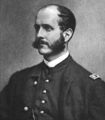Theodore Lyman III facts for kids
Quick facts for kids
Theodore Lyman
|
|
|---|---|
 |
|
| Member of the U.S. House of Representatives from Massachusetts's 9th district |
|
| In office March 4, 1883 – March 3, 1885 |
|
| Preceded by | William W. Rice |
| Succeeded by | Frederick D. Ely |
| Personal details | |
| Born | August 23, 1833 Waltham, Massachusetts, U.S. |
| Died | September 9, 1897 (aged 64) Nahant, Massachusetts, U.S. |
| Spouse | Elizabeth Russell |
| Children | Cora Lyman, Theodore Lyman IV and Henry Lyman. |
| Military service | |
| Allegiance | Union |
| Branch/service | |
| Years of service | May 1863 to April 20, 1865 |
| Rank | |
| Unit | Army of the Potomac |
| Battles/wars | American Civil War |
Theodore Lyman III (born August 23, 1833 – died September 9, 1897) was a fascinating person who wore many hats! He was a scientist who studied nature, a military officer during the American Civil War, and even served as a representative for Massachusetts in the U.S. Congress.
Contents
Theodore Lyman's Early Life and Family
Theodore Lyman III was born in Waltham, Massachusetts on August 23, 1833. His father, Theodore Lyman II, was once the mayor of Boston. His mother, Mary Henderson, came from an important family in New York.
A Family History of Success
The Lyman family's wealth began with Theodore Lyman's grandfather, also named Theodore. He started a successful shipping business in the 1790s. This business created the family's fortune.
The grandfather built a beautiful country home called the Vale in Waltham, Massachusetts. Today, this home is known as The Lyman Estate. It is now a park and museum managed by Historic New England.
Growing Up and Education
Theodore Lyman II, the mayor, retired from public life in 1836 after his wife Mary passed away. Young Theodore, often called Ted, was taught by private tutors. He also traveled a lot in Europe with his father.
When Ted was sixteen, his father died. Theodore inherited a 60-acre (240,000 m2) farm in Brookline, Massachusetts, called Singletree. His older sister, Cora, received the family's town house. They also shared a large amount of money from investments.
Ted's uncle, George Williams Lyman, took over the Vale estate. Cora's husband, Gardner Howland Shaw, helped Theodore get into Harvard University. Theodore graduated from Harvard in 1855, doing very well in his studies.
After Harvard, he continued his education at the University's Lawrence Scientific School. He studied under a famous scientist named Louis Agassiz. Theodore graduated with honors in 1858. He also helped start Harvard's Museum of Comparative Anatomy.
Meeting George Meade
In 1856, while studying starfish in Florida, Lyman met George Gordon Meade. Meade was a lieutenant working on lighthouses for the Army. They became good friends and wrote letters to each other often before the Civil War began.
Marriage and European Travels
In 1858, Ted Lyman married Elizabeth "Mimi" Russell. Mimi's father, George Robert Russell, was a successful merchant and a kind person who gave a lot to charity. Mimi's cousin was Colonel Robert Gould Shaw, who led the famous 54th Massachusetts Infantry Regiment. This regiment was shown in the movie "Glory".
Before the Civil War, Ted and Mimi went on a big trip around Europe. Their first child, Cora, was born in Florence, Italy, in 1862.
Theodore Lyman's Role in the Civil War
Lyman returned to the United States in May 1863. He joined the staff of Major General George G. Meade as an aide-de-camp. This meant he was a special assistant to the general. He was given the rank of lieutenant colonel.
Serving General Meade
Lyman served with General Meade from September 2, 1863, until April 20, 1865. During this time, he kept important records for the headquarters. He was involved in battles, carrying messages through enemy lines at Cold Harbor and Petersburg.
His letters and notes from this time are very important. They tell us a lot about what happened and who was at the headquarters of the Army of the Potomac. After the war, he became a member of the Massachusetts Commandery of the Loyal Legion.
Theodore Lyman's Life After the War
After the war, Theodore Lyman became a state Fish Commissioner. Later, he became a federal commissioner. He was one of the first scientists to suggest using "fishways," which are now called fish ladders. These help fish swim upstream past dams.
Contributions to Science and Education
Lyman was a member of important groups like the American Academy of Arts and Sciences and the National Academy of Sciences. He also helped manage the Peabody Education Fund and was an overseer for Harvard University.
As an overseer, he helped his cousin Charles W. Eliot become the President of Harvard. Eliot held this position for nearly forty years. Lyman was also active in the Massachusetts Historical Society and other historical groups.
Family Life and Health Challenges
Sadly, Ted and Mimi's daughter Cora died in 1869. They later had two sons, Theodore IV and Henry. Theodore Lyman IV became a well-known physicist.
In his later years, Theodore Lyman suffered from a nervous disease. This illness gradually made it hard for him to use his arms and legs. He could no longer work at the Museum of Comparative Zoology. Even with his illness, he remained clear-minded and kept his sense of humor.
He passed away in Nahant, Massachusetts on September 9, 1897. He was buried in Mount Auburn Cemetery in Cambridge, Massachusetts.
Theodore Lyman's Legacy
During his life, Theodore Lyman bought hundreds of acres of land on Buttermilk Bay, Cape Cod. He did this to protect the places where ocean-running red brook trout lay their eggs.
Today, his land and summer home are preserved as the Lyman Reserve. This special place is located in Wareham, Plymouth, and Bourne. It is open to the public and managed by The Trustees of Reservations, ensuring his efforts to protect nature continue.
Images for kids


